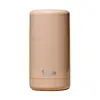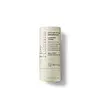What's inside
What's inside
 Key Ingredients
Key Ingredients

 Benefits
Benefits

 Concerns
Concerns

 Ingredients Side-by-side
Ingredients Side-by-side

Caprylic/Capric Triglyceride
MaskingOzokerite
Emulsion StabilisingTapioca Starch
Parfum
MaskingZinc Ricinoleate
Water
Skin ConditioningSalicylic Acid
MaskingAscophyllum Nodosum Extract
Skin ConditioningLaminaria Digitata Extract
Skin ProtectingCalophyllum Inophyllum Seed Oil
AntimicrobialSaccharomyces Ferment
Skin ConditioningLauroyl Lysine
Skin ConditioningGlycerin
HumectantCocos Nucifera Oil
MaskingButyrospermum Parkii Butter
Skin ConditioningMaranta Arundinacea Root Powder
Skin ConditioningCaprylic/Capric Triglyceride
MaskingButyrospermum Parkii Butter
Skin ConditioningCetearyl Alcohol
EmollientSodium Bicarbonate
AbrasiveTapioca Starch
Cocos Nucifera Oil
MaskingCalcium Starch Octenylsuccinate
AbsorbentStearyl Stearate
EmollientParfum
MaskingEuphorbia Cerifera Wax
C15-19 Alkane
SolventZinc Ricinoleate
Glyceryl Undecylenate
EmollientHelianthus Annuus Seed Wax
Skin ConditioningPolyhydroxystearic Acid
EmulsifyingSorbitol/Sebacic Acid Copolymer Behenate
Skin ConditioningGlyceryl Caprylate
EmollientPolyglyceryl-2 Caprate
EmulsifyingWater
Skin ConditioningRosmarinus Officinalis Flower Extract
AntioxidantTocopherol
AntioxidantGlycine Soja Oil
EmollientLavandula Hybrida Oil
EmollientOrbignya Oleifera Seed Oil
EmollientPelargonium Graveolens Oil
MaskingRosmarinus Officinalis Leaf Oil
MaskingMaranta Arundinacea Root Powder, Caprylic/Capric Triglyceride, Butyrospermum Parkii Butter, Cetearyl Alcohol, Sodium Bicarbonate, Tapioca Starch, Cocos Nucifera Oil, Calcium Starch Octenylsuccinate, Stearyl Stearate, Parfum, Euphorbia Cerifera Wax, C15-19 Alkane, Zinc Ricinoleate, Glyceryl Undecylenate, Helianthus Annuus Seed Wax, Polyhydroxystearic Acid, Sorbitol/Sebacic Acid Copolymer Behenate, Glyceryl Caprylate, Polyglyceryl-2 Caprate, Water, Rosmarinus Officinalis Flower Extract, Tocopherol, Glycine Soja Oil, Lavandula Hybrida Oil, Orbignya Oleifera Seed Oil, Pelargonium Graveolens Oil, Rosmarinus Officinalis Leaf Oil
Ingredients Explained
These ingredients are found in both products.
Ingredients higher up in an ingredient list are typically present in a larger amount.
This ingredient is also known as shea butter. It is an effective skin hydrator and emollient.
Emollients help soothe and soften your skin. It does this by creating a protective film on your skin. This barrier helps trap moisture and keeps your skin hydrated. Emollients may be effective at treating dry or itchy skin.
Shea butter is rich in antioxidants. Antioxidants help fight free-radicals, or molecules that may harm the body. It is also full of fatty acids including stearic acid and linoleic acid. These acids help replenish the skin and keep skin moisturized.
While Shea Butter has an SPF rating of about 3-4, it is not a sunscreen replacement.
Shea butter may not be fungal acne safe. We recommend speaking with a professional if you have any concerns.
Learn more about Butyrospermum Parkii ButterThis ingredient is an emollient, solvent, and texture enhancer. It is considered a skin-softener by helping the skin prevent moisture loss.
It helps thicken a product's formula and makes it easier to spread by dissolving clumping compounds.
Caprylic Triglyceride is made by combining glycerin with coconut oil, forming a clear liquid.
While there is an assumption Caprylic Triglyceride can clog pores due to it being derived from coconut oil, there is no research supporting this.
Learn more about Caprylic/Capric TriglycerideCocos Nucifera Oil is obtained from the kernels of the coconut fruit. In other words, this is coconut oil.
Coconut Oil is rich in fatty acids with lauric acid making up the majority of these. It also contains linoleic acid. Due to this high fatty acid content, coconut oil helps trap moisture and soften skin.
Despite being antibacterial, coconut oil may not be great for acne-prone skin. It is comedogenic and may clog pores. This ingredient may not be safe for malassezia or fungal acne.
Note: Coconut Oil should not replace your sunscreen for UV protection. Studies show it only blocks about 20% of UV.
This oil is non-volatile and has a light scent.
The term 'fragrance' is not regulated in many countries. In many cases, it is up to the brand to define this term. For instance, many brands choose to label themselves as "fragrance-free" because they are not using synthetic fragrances. However, their products may still contain ingredients such as essential oils that are considered a fragrance.
Learn more about Cocos Nucifera OilParfum is a catch-all term for an ingredient or more that is used to give a scent to products.
Also called "fragrance", this ingredient can be a blend of hundreds of chemicals or plant oils. This means every product with "fragrance" or "parfum" in the ingredients list is a different mixture.
For instance, Habanolide is a proprietary trade name for a specific aroma chemical. When used as a fragrance ingredient in cosmetics, most aroma chemicals fall under the broad labeling category of “FRAGRANCE” or “PARFUM” according to EU and US regulations.
The term 'parfum' or 'fragrance' is not regulated in many countries. In many cases, it is up to the brand to define this term.
For instance, many brands choose to label themselves as "fragrance-free" because they are not using synthetic fragrances. However, their products may still contain ingredients such as essential oils that are considered a fragrance by INCI standards.
One example is Calendula flower extract. Calendula is an essential oil that still imparts a scent or 'fragrance'.
Depending on the blend, the ingredients in the mixture can cause allergies and sensitivities on the skin. Some ingredients that are known EU allergens include linalool and citronellol.
Parfum can also be used to mask or cover an unpleasant scent.
The bottom line is: not all fragrances/parfum/ingredients are created equally. If you are worried about fragrances, we recommend taking a closer look at an ingredient. And of course, we always recommend speaking with a professional.
Learn more about ParfumTapioca starch is a thickening agent and is made from the cassava root, also known as yucca.
According to a manufacturer, it is an excellent talc replacement.
It is gluten-free.
Learn more about Tapioca StarchWater. It's the most common cosmetic ingredient of all. You'll usually see it at the top of ingredient lists, meaning that it makes up the largest part of the product.
So why is it so popular? Water most often acts as a solvent - this means that it helps dissolve other ingredients into the formulation.
You'll also recognize water as that liquid we all need to stay alive. If you see this, drink a glass of water. Stay hydrated!
Learn more about WaterWe don't have a description for Zinc Ricinoleate yet.